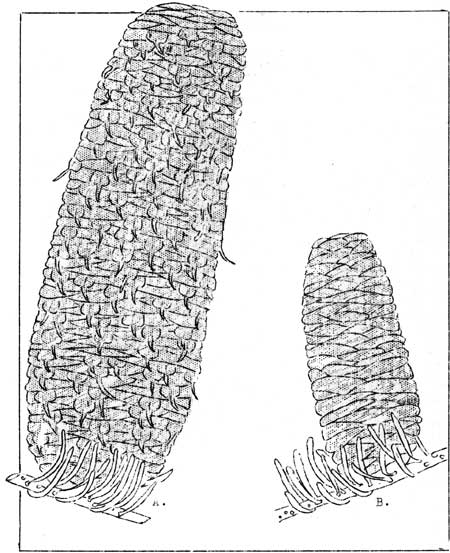NOBLE FIR.
(Abies nobilis)
As the common name implies this tree is, in many respects, the finest
of the true firs in Mount Rainier National Park. While it may be found
at lower elevations it is most common in the intermediate zone, between
3500 and 4800 feet, where it is one of the principal species.
Mature specimens of this tree are usually from 100 to 150 feet
tall and from 2 - 3-1/2 feet in diameter although larger trees
may occasionally be found. The bark is thin, a dark ash-grey in
color, seamed and ridged, and broken up into numerous small plates of
irregular size. The color of the inner bark is a reddish-brown. The
foliage, while varying somewhat in shade, is generally a deep
blue-green with a silvery tinge and it is this character that is one of
the most striking features of this tree. Individual needles are from 3/4
- 1-1/2 inches long. Those upon the upper branches are plump to four
sided in cross section, pointed, densely massed and curved upward so
that they appear to be growing from the top of the branches. Needles on
the lower branches are flat, not curved, and generally notched at the
tip. As in the case of all true firs they leave round leaf scars upon
the branches when they fall or are pulled from them. However, the
handsome and very beautiful cones are the most distinctive feature of
this tree. These are 4-6 inches in length and 2-3 inches in diameter,
yellow-green in color at maturity and with numerous pointed bracts
protruding from between the cone scales. These scales bend down along
the sides of the cylindrical cone to give it a "shingled" appearance.
The cone of the noble fir is easily the most distinctive and unique of
the cones possessed by local conifers. They stand upright upon the
branches and, upon maturity, disintegrate as is characteristic of all
true firs. The wood is rather heavy, fine grained, light brown in
color and of good quality. It is the longest lived of any of our native
true firs, reaching an age of from 200-400 years.
It ranges along the Pacific Coast in Washington and Oregon.
-oOo-

NOBLE FIR (Abies nobilis). A-Cone (x1). Note the numerous
bracts which protrude from between the scales and bend down along the
cone to give it a "shingled" appearance.
ALPINE FIR (Abies
lasiocarpa). B-Cone (x1).
-oOo-
Descriptions continued...

